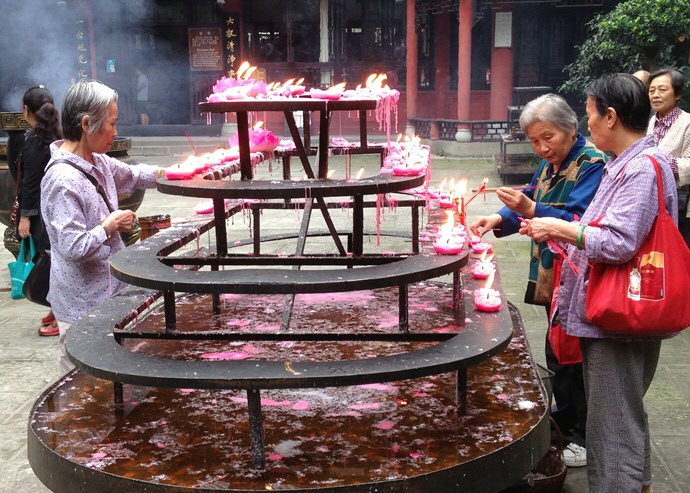Project on religious diversity in China receives prestigious grant

The project Mapping Religious Diversity in Modern Sichuan: A Spatial and Social Study of Communities and Networks has received a prestigious three-year research grant of € 100,000 from the Taiwanese Chiang Ching-kuo Foundation for International Scholarly Exchange . Dr Stefania Travagnin (University of Groningen) and Dr Elena Valussi (Loyola University Chicago) will be co-directors of this project, which will be hosted at the Centre for the Study of Religion and Culture in Asia of the Faculty of Theology and Religious Studies at the University of Groningen.
Focus on Sichuan
During the Qing dynasty (1644-1912), Sichuan witnessed several momentous social changes, and therefore changes in religious culture. Qing emperors actively encouraged migration to Sichuan, implementing policies to attract and retain migrants. This lead to a gradual increase in population, which exploded in the nineteenth century: Sichuan’s population went from 3 million in 1678, to 22 million in 1813, to 85 million in 1898 , greatly altering the social structure. The majority of the population of Sichuan originated from outside the province; t he waves of migration and the establishment of new communities also meant the influx of new religious practices that influenced the local religious landscape. Despite its position far from the centre of political power, Sichuan did not escape the great turmoil that swept across China in the first half of the twentieth century, and it became the destination for further massive migration from coastal areas.
Travagnin and Valussi are interested in researching how this unique historical background influenced religious life and institutions in Sichuan in the Qing and Republican periods, which are the focus of their proposal. This research project focuses on Sichuan as a ‘place’ that needs to be re-located at the centre and not at the periphery of the study of Chinese religions. It shows that Sichuan was an important node in religious networks that originated or developed within the province, and extended beyond it. Thus, Sichuan can be seen not primarily as a site of reception of knowledge transmission from the more advanced coastal areas, but more as a centre of the active production of religious knowledge itself.
Studying the religious landscape of Sichuan in an innovative way
Travagnin and Valussi explain: ‘Our aim is to study religious diversity by carefully analysing communities and networks, specifically interactions between the rural and the urban, the public and the private, and the religious and the lay communities and spaces. The project will not only take into account the five officially recognized religions (Buddhism, Daoism, Protestantism, Catholicism and Islam) but also other religious manifestations that do not fit into these neat categories, like Confucio-Daoist traditions, philanthropic organizations, new religious movements and spirit-writing communities. Rather than highlight static distinctions between religious traditions, we examine active networks, relationships, mutual influences and collaborations. Thus, we are not only focusing on a different territory, but also looking at this territory in a different way, trying to highlight interactions and the permeability of religious borders, and charting how the space itself is an active agent in the formation and development of those relationships and networks. We believe that the case of Sichuan lends itself perfectly to this kind of methodological approach. Finally, we plan to produce a digital mapping of these networks to be used for teaching and research. ’
International and multidisciplinary team
Travagnin and Valussi will lead an international and multidisciplinary team of scholars including Bram Colijn (VU University Amsterdam), Amy Holmes-Tagchungdarpa (Occidental College), Hu Jiechen (Chinese University of Hong Kong), Lars Laamann (SOAS, University of London) André Laliberté (Ottawa University), Volker Olles (Sichuan University), Jonathan Pettit (University of Hawai’i), Annabella Pitkin (Lehigh University), Tsai Yen-zen (National Cheng Chi University), Tsai Yuan-lin (National Cheng Chi University), and Wang Jianchuan (Southern Taiwan University of Science and Technology). The research team will collaborate with several institutions in China and Taiwan including Sichuan University (Chengdu), Southwest Minze University (Chengdu), and National Cheng Chi University (Taipei).
Travagnin, Valussi and their team will conduct fieldwork annually in Sichuan. Travagnin and Valussi are also planning regular conferences, summer schools on the topic, and publications.
The Chiang Ching-kuo Foundation for International Scholarly Exchange
The CCKF is a prestigious Taiwanese funding body that was established in 1989 with the aim to support research on Chinese Studies in the humanities and social sciences. The same foundation has already sponsored two projects at the Centre for the Study of Religion and Culture in Asia: the international conference Framing the Study of Religion in Modern China and Taiwan: Concepts, Methods, and New Research Paths (December 2015) and the two-year postdoctoral fellowship of Dr Andrew Wormald (2015-2017).
| Last modified: | 12 June 2023 8.19 p.m. |
More news
-
15 October 2024
Focus op zingeving en leefstijl in de psychiatrie: Oratie Rogier Hoenders
Focus op zingeving en leefstijl in de psychiatrie met nieuwe leerstoel RUG
-
09 July 2024
As of September 2025 in Groningen: MA track Anthropology of Religion and Culture
The Faculty of Religion, Culture and Society (RCS) announces the accreditation of its new Master’s track in Anthropology of Religion and Culture. This means that the MA programme will start from the academic year 2025/2026. It enables students to...
-
29 May 2024
European joint Master’s degree programmes are among the top programmes
On 27 May, the EACEA in Brussels celebrated the fact that the first Erasmus Mundus Master’s degree programmes were launched twenty years ago.
